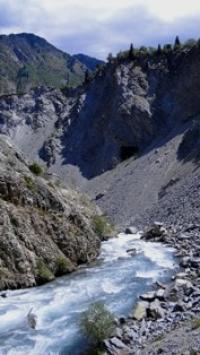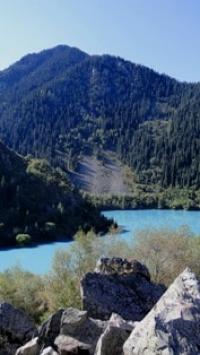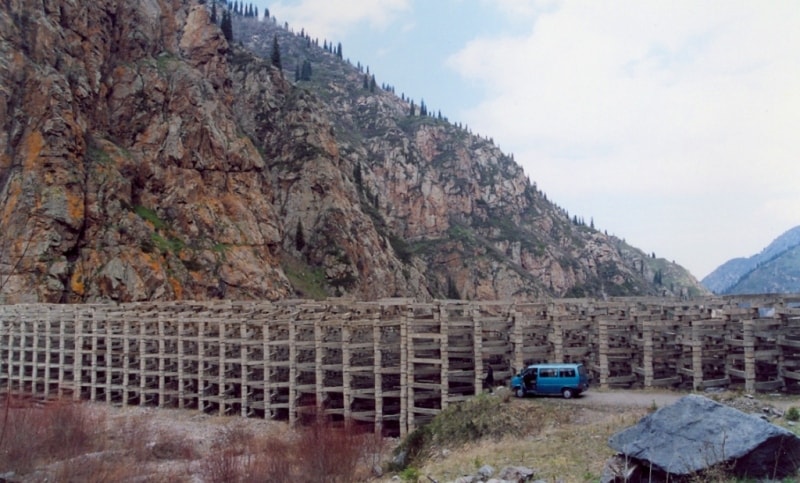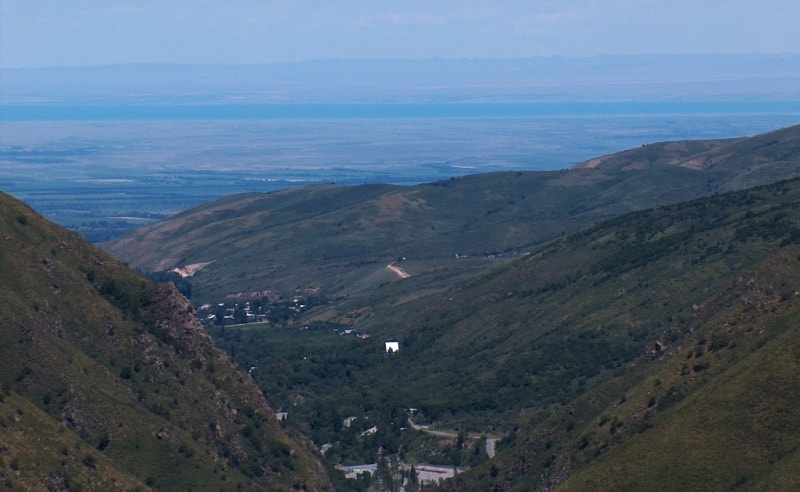Вы здесь
Sights Issyk gorge.


Heritage tourism in Almaty.
“Nature is an infinite sphere whose center is everywhere”
Ralph Waldo Emerson.
Christian tourism in Kazakhstan.
The Sakes are the eastern branch of Scythian (Sakae) ethnos. At that time (from the V - VI centuries ВС till the first century AD) the development of the steppe and mountain spaces, domination of cattle breeding in its various forms in a combination with the agriculture started. Horse breeding was the major direction of the cattle breeding and crops of millet, barley, and wheat provided them with the vegetative food on wintering.
Crafts related to the extraction metals, it's processing connected, in particular, with molding bronze became highly developed. The masters cast daggers, tips of arrows and spears, subjects of harness, ornaments, mirrors and also boilers and altars from bronze, many of which are remarkable products of arts.
Gold figures of animals (Scythian «animal style»), claps, ornaments were made by the certain technology: on a wooden breadboard model masters put a thin gold sheet which was knocked on and thus accepted desirable forms.
The question about how the Sakaes society was organized has caused disputes among the scientists. But it is considered it had three main groups: warriors, estate of priests and estate of those who had two oxen for a plough (so called "eight feet").
The traditional colors corresponded to each of the named estates: soldiers - red and golden-red, priests - white, common people - yellow and dark blue. On the right side two well-seen yurts (tents) located behind the sign "museum" on the 5 - 6 km of the road leading to Esik. It is an open-air museum, which belongs to a well-known Kazakh archeologist Bekmukhambet Nurmukhambetov. In one yurt he lives himself, the various utensils and the weapon that belonged to nomads are presented in the other one.
Near the yurt there's a digging barrow, which can be seen in a cut. The scientist with pleasure will show you the exhibits. The payment is done by the principle « give just what you can ». His information is very professional, as it was him who found a burial place, which is well known in the world as «the Gold person».
The barrow itself didn't remain - on its place there's a cars' station. But, when getting back to the main road and moving in the direction to the city, approximately after 1,5 km on the right side you will see «the Gold person» sculpture in a niche. Here also is the place where that unique barrow is located, with 60 m in diameter and 6 meters high.
After the hill was opened, on 1,2 m depth from a level of ancient horizon two burial places were found out: central and lateral (southern). The central was plundered and the lateral remained intact. A tomb with the wooden cell made of the squared Tien-Shan fur-tree logs has the sizes 2,9 x 1,5 meters and 1,5 meters deep.
The floor is laid out from ten well-adjusted boards. According to the research, the part of a floor was covered with fabric decorated with 4000 fine gold pieces. The corpse was lying on his back, with his head to the West, in smart clothes, with the weapons. By definition of the anthropologists, he was 17 - 18 years old, 165 cm tall.
The southern wall had wooden utensils: four rectangular dishes, a scoop and a bowl. At the western wall there were a clay jug and bowls. There also laid the silver spoon with the bowed handle which end was made in a form of a heron's head, a silver bowl with the eight-petal flower at the bottom, a tiny silver cup with two lines of an inscription of 26 signs.
Behind the person's head there was one more gilt bowl in which there were gold metal plates in the form of a claw and a beak of a predatory - magic signs. The arrow with the gilt staff and a gold tip laid at the left hand. Beside there was the lash, which handle was wrapped up by a gold tape, and the bronze mirror and a slice of ochre was in the toilet leather handbag sheathed with gold.
The dead man was dressed in a suede red jacket, little pieces of which have remained; it was entirely sheathed with golden triangular pieces, simulating a lamellar armor. Leather trousers, filled in boots, are decorated with the edge line of gold pieces, boots' tops are sheathed with the triangular plates, jacket boards - by a number of metal plates in a shape of a leopard's muzzle, and the waist was strapped by a leather belt with massive gold metal plates.
The total sum was thirteen: three in the shape of the unreal creature, horse-deer, and 10 metal plates in the shape of an elk head. The head was decorated with a high leather cap with gold figures of animals and birds, feathers and arrows representing mountains on which trees grow, and the top of a cap was crowned with a tiny figure of the mountain ram. Around his neck was a grivna, ends of which are decorated with leopards' heads, in ear he had earrings and turquoise suspension brackets.
On the two fingers there're rings - one with a smooth shield, another with the image of a head of the person with a nimbus from beams. On a belt was a long sword in a wooden, red painted sheath on the right, and on the left was a dagger. The gold image of a coiling snake is executed on its iron blade. A dagger sheath is decorated with the waybills plates, one with the image of a horse, another -of a deer.
Totally about 4 thousands gold products weighting of 2,9 kg were found in the barrow. The Esik barrow is dated as of 400 ВС. We drive into the city of Esik. Immigrants from Pavlodar founded it as a village in 1858, that time it was named as Nadez.hdinskaya village. During its existence it was repeatedly renamed. The population is 31 000 person. Here there arc companies « Food Master » (dairy production), «Esik wines», «Threeleafplastic», producer of containers and bags for agricultural products.
People of Esik are proud of the tree nursery with the total area of 400 hectares, where over 200 townspeople work. The task of the experts includes planting the various kinds of bushes and trees for the regions of Kazakhstan, south of Siberia, countries of Central Asia. Here for the first time in Almaty area they applied the system of drop irrigation for plants. In the tree nurseries there are about 300 kinds of roses, the local specialists invented 5 of them.
Fruits grow here: apricots, apple-trees various kinds of a hawthorn (with fruits sized from a pin head up to a pigeon egg). From coniferous trees - the blue spruces delivered from Canada; over 20 kinds of maple, including plane trees; 9 kinds of oaks; about 30 kinds of birches.
One more original farm was established 4 years ago - an ostrich farm. When we come there, we'll see not Australian ostriches that we usually see in a zoo, but African, with the height over 2 meters, and weight of 100 kg. Within the last 20 years these farms appear one after another in the Europe. For example, in Switzerland they're more than 60 of them. In Poland there is a farm with 1500 ostriches, in the republic of South Africa - more than 3000. Surprisingly, but snow and cold air seem only invigorating these exotic birds.
Only if the frost becomes stronger they hide inside. In summer they eat clever, lucerne, cabbage, oats, in winter -hey and mixed fodders. And any time in their diet there's enough gravel, which they need not only for grinding the food, but also for formation of an eggshell.
From one adult bird it is possible to get 40 - 50 kg of meat, up to 1,5 sq. m. of leather (used for manufacturing of bags, footwear, thongs), 1.8 kg of feathers, 4.5 kg of edible, 1,5 kg of fat. However, visitors of the farm can buy ostrich's feathers for the moderate payment and take a short tour around.
Taking the main road we get to the city centre and after we cross the bridge over the Esik river at the first traffic light we will turn to the right. To get to the lake we'll drive 14 km on tolerable asphalt road. From time to time we'll have abrupt slopes, but the road is quite accessible not only for the cars, but also for the 50 places buses.
The barrier that crosses the road, a cabin with foresters remind, that in front of us we have an ecological post where we should pay. When passing the post, we drive into the state national park. It was founded in February 1996 and has 4 regional branches. A basis of the park is northern slopes of the Ile Alatau.
The southern border of the park passes on a crest of a ridge; the northern - extends for 30 km and coincides with borders of state woods passing on the bottom line of distribution of coniferous woods. From west on east the park stretches for 120 km, from the Shemolgan river in the West, up to the river Turgen in the East.
The national park is located within the limits of absolute heights from 600 up to 4500 meters above the sea level. Bases of the park nature are the picturesque woods consisting of Shrenk fur-tree and accompanying by the deciduous kinds of trees: Sivers apple-trees, hawthorn, wild apricot, local birch and other wood and bush breeds.
The main goals and tasks of the park are protection and restoration of the unique natural complexes and simultaneous granting the people an opportunity of various kinds of outside leisure.


Authorship:
By the deserved worker of tourism of Republic Kazakhstan, The candidate of pedagogical sciences, the guide - methodologist Lyuterovich Oleg Grigorevich.
Alexander Petrov
photos.







